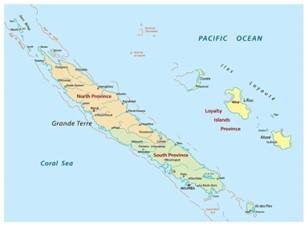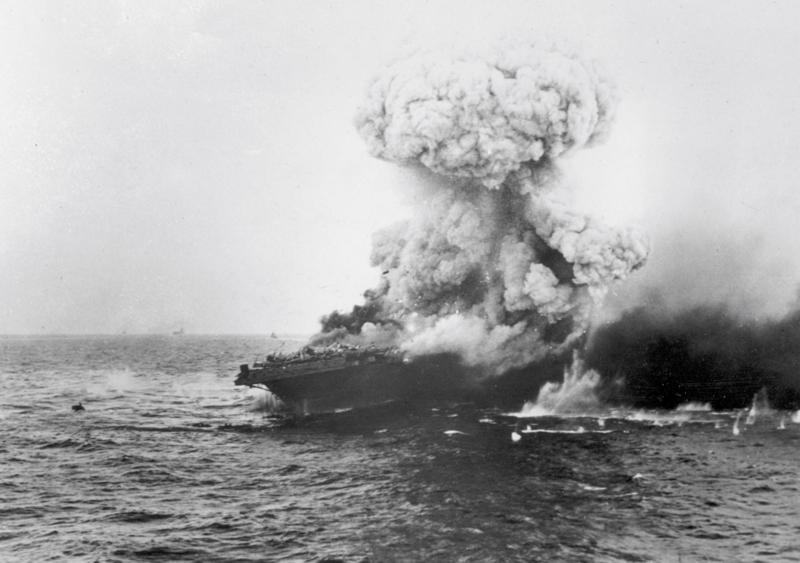Facts and figures
| Official name | New Caledonia |
| Country code | NC |
| Area | 18,575km2 |
| Coastline | 2,254km |
| Population | 271,960 |
| Capital city | Nouméa |
| Timezone | UTC+11:00 |
| GDP | $USD 9.62 billions |
| Currency | XPF (CFP franc ₣) |
| Government type | Parliamentary Democracy (Territorial Congress); An Overseas Collectivity Of France |
| Notable people |
|
The ‘Know Your Region’ series is designed to support unit and individual professional military education on the Indo-Pacific region.
On this page:
- Summary
- Short history
- People and Society
- Media and Internet
Summary

New Caledonia is a special collectivity of France located in the Pacific Ocean, 1200km east of Australia and 670km southwest of Vanuatu. The archipelago is comprised of the principal island of Grande Terre, the Loyalty Islands, the Isle of Pins, the Chesterfield Islands, the Belep archipelago, and numerous small, sparsely populated islands and atolls. Grande Terre is by far the largest of the group at 50km wide and 500km long. It contains about nine-tenths of the population and is home to the capitol Noumea. The island is surrounded by a coral reef that extends from Huon Island in the north to the Île des Pins in the south. It has a diverse landscape with mountains separating the east and west coast. The highest point is Mt Mount Humboldt at 1617 metres. New Caledonia’s lagoons, with their diverse reefs and associated ecosystems, were designated a UNESCO World Heritage site in 2008.
Short History
The first known inhabitants of New Caledonia were the Lapita people who migrated to the islands in about 1500BC. They were followed by mostly Melanesians and Polynesians in 1000BC. In 1774, British navigator and explorer James Cook landed at Balade on the east coast of the mainland and named the island New Caledonia after his father’s homeland (Latin word for Scotland). He was followed by French Explorer, Antoine de Bruni, chevalier d’Entrecasteaux in 1793. Contact with Europeans was limited until the mid-19th century when missionaries began arriving on the islands. The French took procession of New Caledonia in 1853 with the idea of setting up a penal colony. Between 1864 and 1924, about 22,000 prisoners were deported there. Vast tracks of land were confiscated from the local Melanesian population and reappropriated to the new arrivals.
Melanesian uprisings were a common occurrence until the mid-20th century, with France imposing harsh penalties on those responsible, including deportation and execution. Forced labour, limitations on travel, and curfews were enforced from the early days of colonial rule and became the basis of a system of administrative law codified in 1887 as the indigénat (native regulations). This remained in place until 1946, although the legacy of these laws persisted.
Europeans introduced new diseases such as smallpox and measles, which reduced the indigenous population from around 60,000 in 1878 to 27,100 in 1921. To fill a shortfall, large numbers of indentured labourers were imported from other pacific islands, as well as Indonesia, Vietnam, and Japan to work on public infrastructure projects, in the mines, and on plantations. Those who survived their contracts mostly returned home.
In March 1942, with the assistance of Australia, New Caledonia became an Allied base of operations in the Pacific, with the United States Navy and Airforce stationed at Noméa. This was the scene of the famous battle of the Coral Sea that saw the advancing Japanese Navy turned away. The battle was the first naval action in which the opposing fleets neither sighted nor fired upon one another, instead, attacking over the horizon from aircraft carriers. American troops stationed on New Caledonia numbered as many as 50,000, matching the entire local population at the time.

Image: Heavy explosion on board the U.S. Navy aircraft carrier USS Lexington (CV-2), 8 May 1942. – Wikipedia
Throughout the early 20th centuries, France encouraged and facilitated the immigration of European settlers to New Caledonia to establish businesses and expand mining. This influx was part of a broader strategy to consolidate French control over the territory. The colonial administration also introduced policies that prioritised European settlers in employment, education, and political representation.
The Kanaks – French name for the indigenous Melanesians of New Caledonia – began officially advocating for independence from France in the early 1970s. After years of negotiations, in 1998 the landmark Nouméa Accord was signed. The agreement provided New Caledonia with a degree of political freedom, a change of status from overseas territory to an overseas country and then later a unique collectivity. France also agreed to hold three referenda to decide the question of independence, deferred for at least 15 years. The first referendum was held on November 4th, 2018, with 56% of voters opting to remain a French territory. The second vote in 2020 produced a similar result with 53% voting in favour. The third vote, which returned a landslide victory for pro-French loyalists with 96.5% of the vote, is controversial. Kanak leaders had requested the French government postpone the December 2021 vote due to a COVID 19 outbreak leading up to the event; however, the request was denied. In response the Kanaks called for a boycott of the referendum which saw a 44% reduction in the number of ballots cast. While the French Government now sees the matter as closed, for pro-independence parties the issue is ongoing. (See: Hot Topic)
Under the Noumea Accord the French State oversees defence, foreign affairs, law and order, monetary policy, and tertiary education and research while the Government of New Caledonia is responsible for economic development, tourism, agriculture and fisheries, mining permits, culture, environmental protection, social welfare, sports, and primary education.
People and Society
The population of New Caledonia is just shy of 300,000 (2024). The indigenous Kanaks make up 39% of people while Europeans make up 27%. The remaining nationalities are from surrounding Pacific islands or the descendants of workers from Indonesia, Japan, and Vietnam. French is the official language, and the language taught in schools. There are also more than 30 Melanesian languages spoken throughout the islands as well as Bislama – a form of pidgin English. The difference between the Melanesian way of life to the European way are quite polarising and those with mixed heritage are inclined to follow one or the other. There has been little integration between the two cultures. The kanak identity is based on clan membership, a network of family alliances, and specific land rights while the European way (caldoche) is essentially based on a cash economy.
About three-fifths of the people live in the capitol Nouméa, which since 1965 has expanded to embrace the adjacent municipalities of Dumbéa, Mont-Dore, and Païta. Noumea has strong French influences which is evident by the numerous bars, cinemas, museums, and bookshops. European sport is followed closely with football, tennis, and wind surfing being popular with locals.
Melanesian custom remains strong in rural areas, particularly in relation to clan and family ties and obligations. Almost without exception, Kanaks, regardless of their education, return to their villages to take part in elaborate ceremonies and gift exchanges on such occasions as births, marriages, and deaths. Villagers rely on subsistence farming which includes yams, taros, sweet potatoes, and bananas. Women traditionally perform most of the household duties while the men undertake heavier labour such as land clearing. The annual yam planting and harvesting is still a ceremonial and social occasion that sometimes draws urban workers back to their villages for short periods.
With an increase in nationalist sentiment beginning in the late 20th century, there has been a renewed interest among Melanesians in advancing the traditional arts of sculpture, mat and basket weaving, singing, dancing, and wood carving.
Media and Internet
At the start of 2024 there were 241,000 internet users in New Caledonia covering 82% of the population. Social media usage was substantially lower with 144,300 users equal to 49%. Nearly 80% of people had mobile phone connection.
New Caledonia has a small but active media sector with a strong domestic focus. In May 2023, the territory’s only daily newspaper, Les Nouvelles Calédoniennes shut down, leaving 120 people unemployed and creating a gap in in-depth reporting. This leaves the local media landscape dominated by French-State-funded public broadcaster NC la Premiere (television, radio, online). There are four other radio stations, including Djiido (pro-independence) and RRB (pro-France), which are struggling financially.
For further information on New Caledonia, see the resources below:
Video
Articles
- New Caledonia country brief | Australian Government Department of Foreign Affairs and Trade (dfat.gov.au)
- New Caledonia – French Overseas, Melanesia, Pacific | Britannica
- Country Profile – BBC
- Country Profile – The World Factbook - CIA
- New Caledonia, French Territory In The Pacific – WorldAtlas
- New Caledonia – Everyculture.com
- Demanding the Future: Navigating the Pacific's Youth Bulge (lowyinstitute.org)
- French Riviera in the South Pacific – Luxury Travel Magazine
- New Caledonia Tourism : The official website for tourism in New Caledonia
Know your region
Know Your Region series gives you a shortcut to understanding other nations in the Indo-Pacific region.









